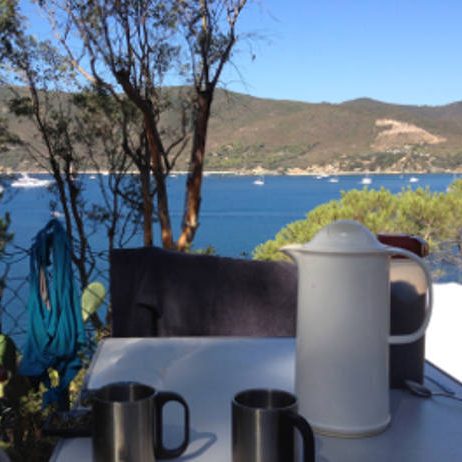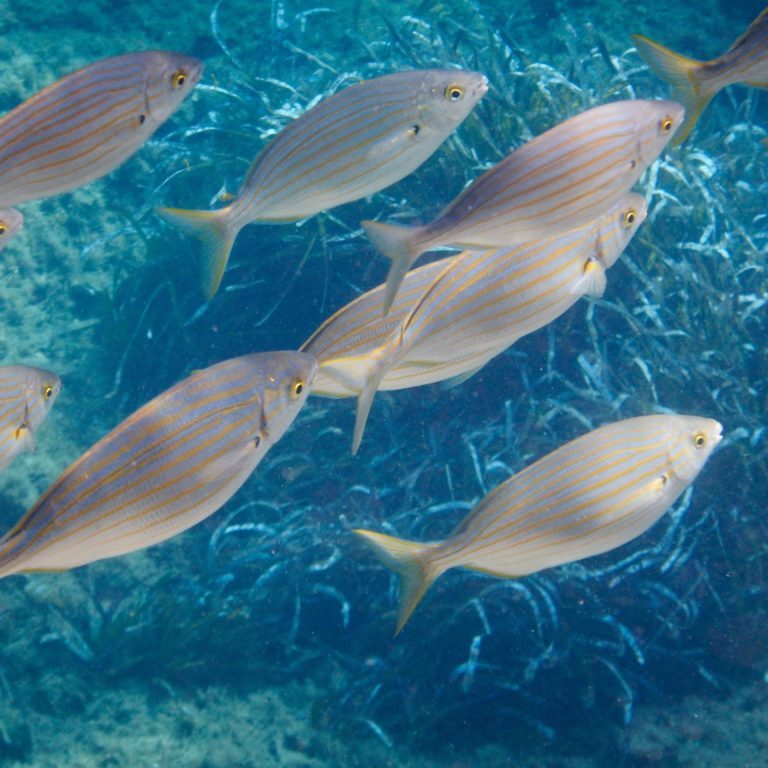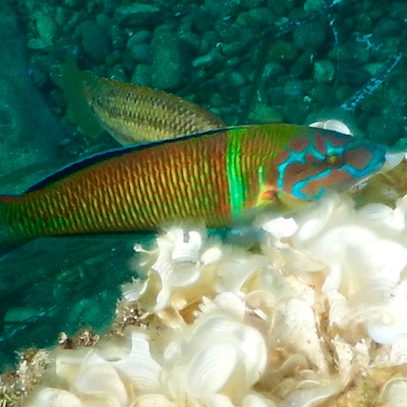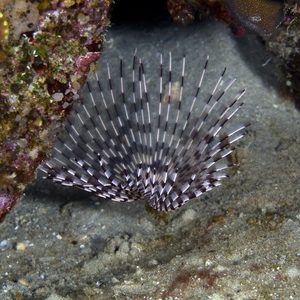Elba
General
Mediterranean island in Tuscany, Italy, 10 kms from the coastal town of Piombino. It is the largest island in the seven island of the Tuscan Archipelago, off the Italian coast about 50 kms east of the French island of Corsica. Population of about 30,000, which increases up to 150,000 in the summer.
29 kilometres long and 18 kilometres wide, the island is easy to drive around, with good cycle routes, and a network of bike trails for all abilities, with good accessibility for biking families. The largest town is Portoferrairo (pop 12,000). Napoleon lived here for most of a year (photo of his house, right).
The climate is predominantly Mediterranean. It's in the rain shadow of Corsica, so rainfall tends to be less than on the mainland.
Currency: Euros. €1 = £0.90. = = US$ 1.18
There is an airport on the island, which has flights to Italy and Switzerland. Most people get onto the island via the four ferry companies that go between Piombino on the mainland and Portoferraio, Cavo, Rio Marino and Porto Azzurro. Ferry from Piombino to Portoferraio takes about an hour.
Time in Elba: GMT + 01.00 or 02.00, depending on Daylight Saving Time
Entry requirements: valid passport, return ticket. Standard EU entry terms.
Visas? Not for US or EU, but needed for certain countries. Italy is a member of the Schengen Agreement. See https://www.schengenvisainfo.com/italy-visa/
(written August 2017)

Climate charts for Elba
The annual averages above look a little low: in August 2017, for example, the air temperature was a steady 35 degrees for much of the time. It can be hot.
See http://en.allmetsat.com/climate/italy.php for temperature and rainfall.
https://www.seatemperature.org/europe/italy/campo-nellelba-august.htm for sea temperatures.
Sea temperature is warm enough for comfortable snorkelling in the summer months.
The UK Foreign Office does not provide any warnings about Elba, but advises you to take your European Health Insurance Card.
Elba August / September 2016
This island is most famous as Napoleon's prison between May 1814 and February 1815 (300 days), but this is an unfortunate description of a beautiful, captivating place to visit.
The island has 140 miles of coast, warm water, good visibility and a variety of sheltered coves and bays. Although you will see a lot of fish, varieties are restricted compared to other places: this is the Mediterranean, not the Red Sea.
The first thing to remember about Elba is that snorkelling depends on wind direction: you get much better sea when you are sheltered from the wind (ie it's blowing onto the other side of the island). For a good description of this, and a runthrough of 61 local beaches and four snorkelling routes, we recommend the excellent local book New Guide to Beaches - Island of Elba (€6, sole distributor Vannucci Ivana, email [email protected]).
We arrived in Portoferraio, drove 40 minutes, and stayed in the Camping Stella Mare, a campsite overlooking near Capoliveri in the Gulf of Lacona, and every day walked down the 110 steps to the sea - this is a hilly island, and there's a lot of climbing. The sea shore has a lot of Neptune Grass (Posidonia oceanic) and white rocks, and we saw what were to become very familiar fish - banded sea bream, saddled sea bream, wrasse, goldline (Sarpa salpa or cow bream) some small black fish that looked like black anthias (?), and pipefish swimming just below the surface of the sea.
If you're lucky, you might spot a noble pen shell (Pinna nobilis) standing upright on the sea bottom. These are the largest bivalve molluscs in the Mediterranean, are susceptible to pollution and breakage from anchors, and are now a protected species. They are also known as 'the castanets of the sea'. If you look hard you will find some sea anenomes.
Boat trip 1
We decided to start boating round the island, so took a boat from Sottolonda Diving Centre on Lacona Beach (email [email protected]), and, for €20 per person, took a trip to Pomonte.
The 8-metre 250 Yamaha outboard rib left Lacona Beach at 3pm with 15 passengers and three crew on board. This was a genuine snorkel trip, not a converted diving excursion, which was good, so the passengers were of varying abilities. The rib took 40 minutes to get to the Grotta Azurra (Blue Grotto) near Cavoli Beach. This is a small sunken cave with interesting rocks, clear visibility, and plenty of bream. It was a very popular site, however, so there were four pedallos, eight boats of various sizes, and a small dog. It was chaotic, busy, but good fun.
After that we travelled to Pomonte, on the western point of the island, to visit a wreck. The Elviscott was a 35-metre cargo ship travelling from Naples to Marseille when it was caught in a heavy storm and hit the rocks outside Pomonte in 1972. It was beached for several months before breaking up and sinking. It now lies in 4 to 12 metres of clear water. All wrecks are poignant, and so is this one.
For a snorkeller, however, this is one of the best opportunities you will find of seeing a wreck close to: usually they are much deeper than this. The wreck was exciting, dramatic, and full of fish. Well worth a visit. However, as before, this is a very popular site. We counted twenty boats, six pedallos, and a couple of very large boats (50 to 100 passengers) arrived as we left, with people jumping in from the upper deck.
In short, the trip was very enjoyable but not classical quiet snorkelling - more like a party in the sea. The crew were friendly and professional, it was cheap for a three-hour trip, and we saw things we hadn't seen before. Would we recommend it? Yes. But be aware - you are not alone.





Fish spotting
Gill had been spotting what she thought was a Moon Wrasse, but they only occur in the Indo-Pacific. She finally photographed it today - an Ornate Wrasse (Thalassoma Pavo) a sub-tropical fish that has become acclimatised to the Mediterranean. The male and female stay around the same area - shallow rocks bordering Neptune Grass - and are a real find. We also watched some small red shrimps and photo'd young blue fish which seem to be the young of the brown anthias.
We also saw a jellyfish - the Licorice Allsort (our name - it's actually called the fried egg jellyfish, Cotylorhiza tuberculara) our second of the trip - the first had four legs and a pale white pulsating body. Its sting has little effect on humans.
Boat trip 2
Went out again, this time along the Capoliveri Peninsula, to the two islands known as Gemini. More knowledgable snorkelling crowd, 18 in all, wetsuits and fins. 45-minute ride along the coast, looking at small coves and bays. Gemini has an enclosed causeway between the islands, which makes for safe snorkelling, good visibility, rocks but not much in the way of interest.
After that we went round the islands to a black beach that had been coloured by the iron mine. Everything was black - the sand, the rocks, the marine life. Steve saw a black crab with golden jewels on it, and Gill saw - and photographed - a black and gold eel.
Again, it was a fun expedition, but not really very productive in what to see.
Other things to do on Elba - you could visit Napoleon's villa in Portoferraio, difficult to find but worth a visit: there's a market in Lacona on Thursday: and sometimes there's live music in some of the bars.
Wind changes and feather dusters
On our last day, there was a strong south-westerly wind, which completely changed the nature of our cove. There were strong waves, undercurrents, almost no visibility and the churning sea was full of weed and detritus. If we had had these seas for the first week we would have been very depressed.
On the other hand, it was exciting to be thrown around for a while, and other marine species take advantage of the sea change. There were multiple shoals of small fish darting round the shallows, and for the first time we saw an annelid worm - we think it was a feather duster - feeding.
There are 19,000 types of Annelida, including leeches and earthworms, but this one looked like a small feather duster rooted on the side of a rock, with orange-yellow fronds waving in the current. These fronds are part of the worm itself, and are very effective plankton-collectors. They are light-sensitive and retract in the presence of a large fish or a swimmer - but they like rough seas and strong currents as there's more food around. The moral of the story is, different seas bring different rewards if you keep your eyes open.
We also identified a painted comber during our stay, and a rainbow wrasse.

Napoleon - not just a funny hat
If you mention ‘Elba’ to most people, their response will be ‘Napoleon’ - so we decided to research the great man while we were on the island. Andrew Roberts’ Napoleon the Great is a good place to start, especially while visiting Napoleon’s house of exile in Portoferraio.
It was a revelation - up to now we had thought that his main contribution to history had been having haemorrhoids which prevented him winning the Battle of Waterloo. In fact, he was a polymath with astonishing achievements under his belt.
A general at the age of 24, he conquered the Italian peninsula two years later, winning almost every battle and becoming a national hero. He had unbelievable military successes, and in 1804 he became first Emperor of the French. His victory at the Battle of Austerlitz led to the elimination of the 1,000-year-old Holy Roman Empire. Eventually he over-reached himself and the French army came apart after invading Russia in 1812.
Ok, so he was a brilliant General. But what sets him apart, in British eyes at least, was that he was a fantastic law-maker too. He was so full of ideas that different teams of secretaries were employed to write them down. He introduced liberal reforms into most of the countries that he conquered, including the Netherlands, Belgium, Switzerland and parts of Italy and Germany. The Napoleonic code has influenced more than 70 legislatures round the world. He was interested in science, art, poetry, literature and design. In British terms, he was like Churchill, Lord Denning, and Stella McCartney all rolled into one.
He was exiled to Elba after signing the Treaty of Fontainebleau, and arrived in May 1814. During his stay on the island, he rearranged the administrative system, extended the roads, endowed a hospital and designed Elba’s flag (still in use today). Ten months later, he left the island, faced down the police and soldiers who were sent to arrest him, got to Paris, where his former troops rejoined, and Emperor Louis XVIII fled into exile. Napoleon ruled again for 100 days before becoming undone at Waterloo.
Astonishing man. Well worth visiting the rather humble Villa San Martino, where he made his home.
Finally, two of his quotes. Do they have resonance in 21st Century politics?
“If you wish to be a success in the world, promise everything, deliver nothing.”
“In politics... never retreat, never retract... never admit a mistake.”
Would we go again? Probably not for the snorkelling.Beautiful place, but there are lots of others on the list...

Usual warning: we have made very effort to make sure this information is correct and up-to-date, but you need to check it all yourself.
© Garreg Lwyd Ltd 2018
Do you have any comments, or recommendations? Send us a message! We'd love to hear from you...
